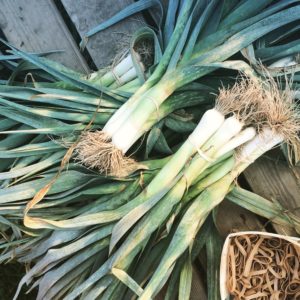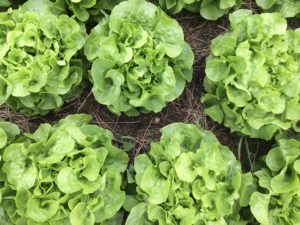Top 10 Vegetable Exit Strategies (When You’ve Got Veggie Overload)
My refrigerator is going to explode.
It’s the time of the CSA season, when the sweet corn husks take over half the bottom shelf, my three heads of cabbage are stuffed into the back right corner, and my last 3 weeks of beet roots are multiplying in the Debbie Meyer green bags.
If trying to “clean out the fridge” and use up the whole box is one of the goals, then let’s not forget that I am at more of a “disadvantage” than the average CSA member.
I’m the farmer’s wife after all, so I sometimes take pity on those 5 orphan cabbages and carrot bunches that show slight damage, and wouldn’t be sale-able at the market.
“What a shame to compost that,” I think. “I’ll just cut the bad parts out, and I’ll freeze them for the winter.”
Except now I have to actually find time to do that.
And in the meantime, they hang out in the fridge.
CSA members, if you’re reading this, and you’re starting to feel like you’re drowning in the deep end of veggies, I want to remind you of “STEP 6” of our CSA weekly roadmap.
Use the vegetable “exit strategies.”
Step 6 is kind of like pulling the fire alarm when the building’s on fire.
Lights flare. Sirens blare. “Red alert! Red alert!” Something must be done.
Can’t… handle…. all…. the food….
I felt the alarm going off this week, as I started to feel like I was losing control of the produce inventory.
Let me describe what’s going on in my brain. I feel this pressure to produce a delicious meal for the family from my box every night, so that I use it all up. But then I look at the beets, and I just can’t make potato beet latkes one more time, or my kids will declare a mutiny. And it’s been so daw-gone hot in my non-air-conditioner house, that roasting has been out of the question.
And I just went to Meijer to get some groceries, and there is NO ROOM FOR MY MILK, SOUR CREAM AND YOGURT because the beet bags and corn husks are taking the entire bottom shelf over.
It’s time for drastic measures. Step 6…
Vegetable exit strategies.
I love this term.
I made it up after researching my CSA masters this summer, and asking them what they do in situations I just described. How do they figure out ways to keep up with the box? How do they get rid of an abundance of items that stockpile, OR veggies that are less “desirable.”
Over and again, they cited types of preparations they perform to clean out their inventory. And I named them “exit strategies.”
As it turns out, there is a Top 10 list. And I’m going to share it with you today, just to remind you.
I know that you already know how to make a basic stir fry or that you can grill a zucchini. But sometimes, it helps to have ALL the options in front of us as a quick list to help remove the paralysis, so we can make a decision.
When I hear the sirens go off, I pull out my “Meal Templates” tool (a list of all the exit strategies in one document) and stare at it. It reminds me what I can do with beets besides beet/potato latkes.
I especially pay attention to the top 10 exit strategies. And if you’re a new CSA rookie, these are the cooking methods you should try to master FIRST.
You’ll see bigger return on your investment if you do. And that’s motivating!
So here’s the list. Overwhelmed or uninspired by something in your fridge?… See if you can do this with it:
Freeze it —

Don’t compost that kale! Blanch and freeze it! It has a totally different taste! I like to hide the wilted kale cubes in spaghetti sauce, pasta dishes, soups… you don’t even taste it!
If I’m overwhelmed, I immediately ask myself, “Can I freeze it for later?” I keep a stack of freezer ziplocks in my pantry, and my ice cube trays on retainer in case I need to blanch and freeze.
Because the truth is, just about every veggie can be frozen (except lettuce and cucumbers). And that’s pretty powerful.
Last week, Josiah’s garden of green beans flushed out its second harvest. I had at least 4 peck baskets of beans. No way was I gonna get through that.
Solution: Blanched them all by steaming them, dunking them in an ice bath, and freezing them on a cookie sheet (I placed a dish towel on the pan, which really helped them not stick later). Popped them into gallon size Ziplocks. Now I’ve got winter veggies.
Took me two nights — 20 minutes per night.
If you’re a CSA rookie, make it a goal to try and learn how to freeze 5 different veggies this season. If you add this skill to your arsenal, in my humble opinion you just justified your CSA membership fee.
Roast it —
Easily the second most listed exit strategy. Again, most veggies can be tossed in a modicum of olive oil and kosher salt, some other light seasonings of your choice, and laid on a sheet pan to roast at 400 F for 20-40 minutes. BOOM. Instant dinner.
What’s even better is that you can let them cool, and pack it into a freezer bag and freeze it for later.
This is what I plan to do with all those dang beets.
Stir Fry —
Definitely at the top. Throw it into a big wok or frying pan with some olive oil, toss in some other veggies — onions, garlic, can of beans, soy sauce. BOOM. Insta-meal in 20 minutes.
Sheet Pan Meal –
This is a close cousin to the Roasted Exit strategy. Check out our video tutorial.
But simply google this on YouTube, and you’ll see a TON of suggestions.
The concept is simple. Put your protein, veggie, and starch (like a potato) on the same sheet pan, tossed in olive oil and herbs. You may just have to add some of the ingredients to their side of the pan a bit later in the cooking process. At the end, it’s this wonderful mish-mosh of flavors, and one simple clean-up.
Unless you used foil, and then it’s zero mess.
Freezer Scrap Bag: DIY Broth –

Don’t throw away the tops of your leeks! Save them in a freezer scrap bag and use them to make your own veggie broth.
This is another mind-blowing strategy that will amaze the rookie CSA member. I still remember the light bulb feeling that went off when I learned I could make my own veggie broth (or chicken broth) with my vegetable SCRAPS.
As in carrot peels, onion peels, carrot tops, green onion tops, garlic ends and peels.
I know. Is your brain on fire right now?
Now, not only am I not wasting ANYTHING, but I don’t have to buy stock EVER AGAIN. (And I haven’t, since I learned this trick).
I won’t bore you with how to make it here. But you can watch this video tutorial if you’re intrigued.
Soup –
Another “duh” – nothing-new-here concept. But what I recently learned is that you can prep “Ready-to-assemble-soup-bag” where you put all the uncooked ingredients into a Ziplock bag and pop it into the freezer for the winter. Then pull it out later to finish cooking.
We’ve got a sample recipe here of Beef Cabbage Soup to give you an idea of what we mean.
You can do this with a lot of veggies. Then all you have to do is add in the broth when it’s time to make it later.
Salad —

Try to eat your salad greens within the first 3-4 days of getting them. This is one of the few greens that you cannot blanch and freeze. So enjoy it fresh!
So many people mentioned this in my research, and there’s no way to make it sound sexy. But the trick here is to learn to use the “danger zone” veggies (the ones that spoil really fast) in the first 2 days to make the salad.
If you’re sick of green lettuce salads, think outside the box. Couscous, quinoa, vinegar-dressing, slaws, dried fruit, goat cheese can add a powerful new flavor punch to boring lettuce.
I’m not implying that lettuce is boring…. but sometimes… you can feel uninspired.
Simple pan saute –
Oh my gosh, this one is so under-rated. I bet that half the time I don’t know what to do with something, I end up just chopping it or shredding it up and throwing it into a skillet with some olive oil and spices. It’s sauteed, steamed, crisped — whatever you call it — and you’ve got an instant side.
A LOT of our CSA masters do this.
Great tasting food doesn’t have to be complicated.
Pesto –
I feel like this one should be higher up on the list, because it seems like Cadie and I have been doing so many pestos in our cooking tutorials.
The fact is, all those leafy greens you get in the early part of CSA?… well, they go great in pesto. So if your’e sick of leafy salads, and you don’t want to pan saute it, pesto might just be your best bet.
Keep a stash of pine nuts or walnuts around, as well as some parmesan cheese — and you can throw together a batch of pesto anytime.
Plus, it freezes in a Ziploc bag and thaws really fast in a hot bowl of pasta this winter. BONUS!
Grilled –
I see so many of our members post pictures of grilled produce on our private Facebook page. I love this, because it’s kind of like roasting, done outside. The flavors of veggies will caramelize and often change completely when roasted.
For example, try a grilled radish. TOTALLY different taste than raw. Creamy texture, almost like a potato.
Did you actually make it all the way down the list? (I’m impressed).
Obviously, there are more “types” of meals you can prepare. My masters also mentioned things like “pickle, quiche, sandwiches, juicing, and sauce.”
But if I had to identify the BIG GUNS, these would make the top of the list.
What that means, is that if you are a CSA rookie, and you need help clearing your inventory, run your veggie overload through these top 10 strategies.
And focus on learning THEM first.
I finally cleared the bottom shelf of those 15 pounds of red beets.
I am at peace again.
Don’t minimize Step 6. Use the exit strategies. They work.
